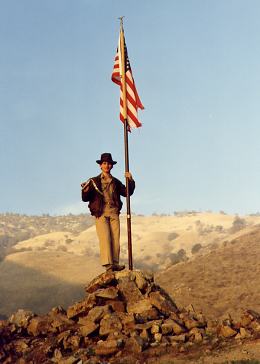
PETER MERLIN AT THE MEMORIAL WITH THE FIRST FLAG DEC. 28, 1986
 PETER MERLIN AT THE MEMORIAL WITH THE FIRST FLAG DEC. 28, 1986 |
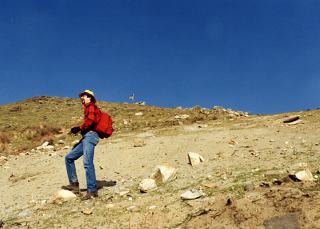 WADE COOKSEY AT THE AIRCRAFTS POINT OF IMPACT DEC. 28, 1986 |
Peter Merlin first visited the F-117A crash site on 28 December 1986. He and Wade Cooksey planned their trek by studying maps and plotting the airspace restrictions that had been in place during the accident investigation. Pete overlayed the restricted airspace boundary on an aeronautical sectional chart, the type used by pilots to navigate. The center of the restricted zone fell in a steep tributary of Kern River Canyon. Next, Pete transferred the approximate location to a more detailed topographic map.
To reach the site, Pete and Wade crossed the Kern River and hiked up the steep canyon to the crash scene. By now, fresh green shoots of grass had begun to sprout on the blackened earth. In contrast, the impact point stood out as a white indentation of pulverized granite. The airplane had struck the ground at a steep angle, blasting debris hundreds of feet in all directions. Nearby trees were still charred black. A smoky odor competed with earthy scents. Water burbled from a spring below the crash site and the flag flapped gaily in the breeze. A hawk soared overhead.
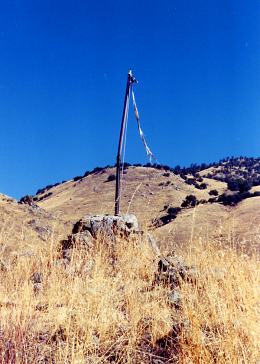 THE REMNANTS OF THE FLAG AS WE FOUND IT ON SEPT. 12, 1999 |
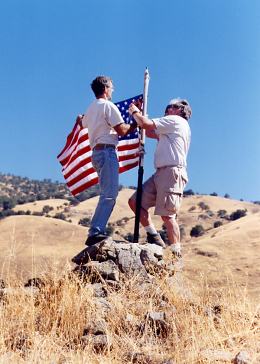 TONY MOORE AND JEFF HUDSON REPLACE THE FLAG SEPTEMBER 12, 1999 |
Pete revisited the site with Mark Miller on 4 August 1990. To their surprise, they found a brand new flag in place. This was most likely the third flag to grace the site, probably replacing on that had been placed in July 1988. The impact point was no longer well defined. Grass had begun to cover the scar.
On 1 August 1992, Pete took Tony Moore and Eric LeVeque to the crash site in Kern River Canyon. They forded the mighty Kern and climbed a steep ridge adjacent to the tributary canyon. By now the impact point was almost completely overgrown and no longer served as a landmark. Approaching the site, they spotted the flag, hanging limp, on a shortened pole. The brass eagle was missing. The pole was shorter too, having broken and been crudely repaired. The flag, however, was brand new.
Pete took photographer Marc Solomon to the site on 30 January 1993. They found the flag badly tattered by the wind. This was probably the last flag placed by the Air Force. By now, the F-117A unit (the 4450th Tactical Group had become the 37th Tactical Fighter Wing) had moved to Holloman Air Force Base, New Mexico. Mulhare's colleagues had transferred or retired. There was no one left to replace the flag at Mulhare's crash site.
When Pete revisited the crash site on 1 January 1998, he found the flag completely destroyed. Shreds of it were scattered about the canyon. He decided it was time to do something about it.
On 12 September 1999, Pete returned to the site with Tony and several friends. Pete unfurled a new flag while Tony attached it to the pole. Once again the Stars and Stripes flew proudly over the canyon, a lonely monument to a Cold War hero.
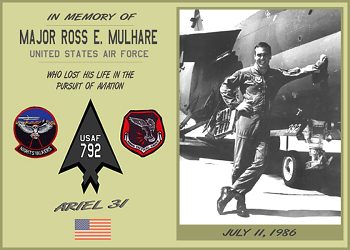 |
